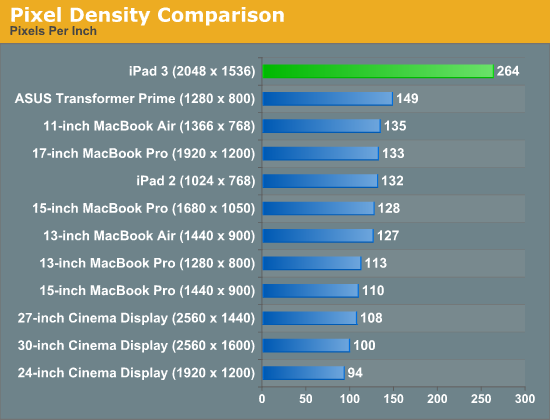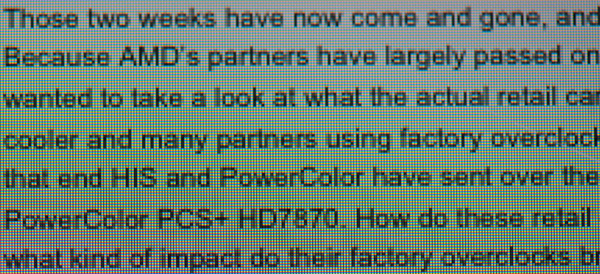The new iPad: Retina Display Analysis
by Anand Lal Shimpi on March 19, 2012 5:49 PM ESTWe're hard at work on our review on the new iPad but with a fair bit of display analysis under our belts I thought a quick post might be in order. One of the major features of the new iPad is its 2048 x 1536 Retina Display. Apple kept the dimensions of the display the same as the previous two iPad models, but doubled the horizontal and vertical resolution resulting in a 4x increase in pixels. As display size remained unchanged, pixel density went through the roof:

Although the iPad 2 has a fairly high pixel density compared to most of Apple's Mac/display lineup, you're more likely to hold a tablet closer to your eyes which made the low resolution/pixel density problematic. The new iPad addresses this issue as you can see from the chart above. I can't focus closely enough to the panel to actually make out pixels on the new iPad, much less at a normal viewing distance. With the aid of a macro lens we can definitely identify individual pixels. The improvement over the iPad 2 display is striking:
To the left we have the original 1024 x 768 panel, and to the right we have the new Retina Display. At this distance you can still identify individual pixels, an ability that quickly vanishes at normal viewing distances. The Music app icon is an even better example of what you gain from the newer display as it has more high contrast edges that appear more aliased on the 1024 x 768 panel:
The old iPad's 1024 x 768 resolution was fairly bothersome when it came to reading text on web pages or books. Most Android tablets standardizing on 1280 x 800 offered an advantage in that respect, albeit not delivering significantly higher pixel density. The new iPad completely resolves this issue. Hover over the links below to see roughly the same paragraph of text from our retail Radeon HD 7870 review on the iPad 2, new iPad and ASUS Transformer Prime:

| Apple iPad 2 | Apple iPad (3rd gen) | ASUS TF Prime |
| original | original | original |
While it's still obvious that you're looking at a screen and not an e-ink display, the pixels perform a good disappearing act on the new iPad.












172 Comments
View All Comments
solipsism - Monday, March 19, 2012 - link
I was hoping they would have increased the brightness levels. It's always been too low for my tastes. Still, if I had a choice between a brighter display and double the resolution I would chose the latter. Now that it's done I'm hoping for a brighter display next year.PS: I've noticed that it fairs better in the sunlight than the previous model even without using an extra bright backlight to achieve that goal.
mavere - Monday, March 19, 2012 - link
http://www.displaymate.com/iPad_ShootOut_1.htm#Ref...The new iPad seems to have mitigated glass reflection issues.
Owls - Tuesday, March 20, 2012 - link
Why is the PPI relevant when ipad is still using a 9.7 inch screen? Why don't other tablet makers use a 9 or 9.5 inch screen with the same resolution and boast about how revolutionary it is?DorkMan - Thursday, March 22, 2012 - link
What I want to know is how much real-world improvement there is.Doubling the PPI in both axes is fine if it makes an obvious difference and doesn't cost much in terms of other factors such as weight, heat, fragility, and a host of other variables.
Otherwise, it's a plus only for nerds who need to justify Apple under any circumstances and who will be happy to whip out a 10x magnifying lens to show the unimpressed just how sharp an icon really is.
So, please, an objective assessment. Don't be like Mossberg of the Wall Street Journal who can be counted on to laud everything Apple does while condemning with faint praise everything the competition does.
michael2k - Thursday, March 22, 2012 - link
Of course it is. Anand said so:"The old iPad's 1024 x 768 resolution was fairly bothersome when it came to reading text on web pages or books. Most Android tablets standardizing on 1280 x 800 offered an advantage in that respect, albeit not delivering significantly higher pixel density. The new iPad completely resolves this issue."
vishal_ec - Monday, March 19, 2012 - link
hopefully the rest of the benchmarks are coming soon. Sunspider, and others that test cpu/ram etc.Also, what i think would be also another useful set of benchmarks that would mean a lot more to end users would be say loading of websites (pick top5 and average them). a few popular games performances. launch times for a few popular apps.
MonkeyPaw - Monday, March 19, 2012 - link
Yeah, I think it's going to need that fancy GPU Apple has been touting. 3.1M pixels versus 786K? Will it have enough memory bandwidth? I guess that's for reviews to say. :)tipoo - Tuesday, March 20, 2012 - link
Browser results are already up on reviews from The Verge and Engadget, like expected they are unchanged. Its using the same two Cortex A9 cores after all. Only the GPU and RAM are changed.Lucian Armasu - Tuesday, March 20, 2012 - link
I want to see GPU benchmarks for their native resolution, too. While it's certainly nice to compare how fast a GPU is in theory, what really matters is how fast the *device* itself is.So I'd like to see how the new GPU fares when it has to push 4x the amount of pixels. That's why I want it benchmarked at its own 2048x1536 resolution instead of the fixed 720p one that's usually in benchmarks here.
Fanfoot - Tuesday, March 20, 2012 - link
What I'd like to see is more details about the display, in particular measuring things like power draw compared to the display on the iPad 2. It appears that the new display takes something like 70% more energy for the same brightness. Which is why the battery is 70% bigger. Is this something that is temporary or will each advance increase the power draw again? Will Asus' upcoming Full HD Transformer Prime have to have a similarly beefed up battery to avoid suffering much worse battery life than its 720p parent? Is there a display technology on the horizon that can ameliorate this power draw any time soon, while still achieving the new higher resolution?How about the battery? Sounds like the battery density on this iPad is NOT any better than the one in the iPad 2, but is in fact just 70% bigger and heavier. Can you confirm these numbers? How is it the new iPad isn't even heavier and thicker than it is? Did Apple weight reduce the frame a lot? Do something with the bonding on the glass to save weight? Or what? Are there any consequences to this like reduced stiffness or hardiness when dropped? Is the heat people are noticing not just because the A5X generates more heat but also because the aluminum is thinner?